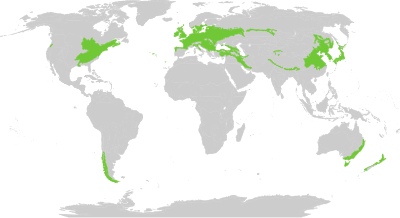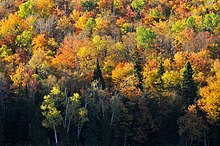Temperate broadleaf and mixed forests
Temperate broadleaf and mixed forest is a temperate climate terrestrial habitat type defined by the World Wide Fund for Nature, with broadleaf tree ecoregions, and with conifer and broadleaf tree mixed coniferous forest ecoregions.[1]


These forests are richest and most distinctive in central China and eastern North America, with some other globally distinctive ecoregions in the Himalayas, Western and Central Europe, the southern coast of the Black Sea, Australasia, Southwestern South America and the Russian Far East.[1][2][3]
Ecology edit
The typical structure of these forests includes four layers. [1]
- The uppermost layer is the canopy composed of tall mature trees ranging from 30 to 61 m (100 to 200 ft) high. Below the canopy is the three-layered, shade-tolerant understory that is roughly 9 to 15 m (30 to 50 ft) shorter than the canopy.
- The top layer of the understory is the sub-canopy composed of smaller mature trees, saplings, and suppressed juvenile canopy layer trees awaiting an opening in the canopy.
- Below the sub-canopy is the shrub layer, composed of low growing woody plants.
- Typically the lowest growing (and most diverse) layer is the ground cover or herbaceous layer.
Trees edit
In the Northern hemisphere, characteristic dominant broadleaf trees in this biome include oaks (Quercus spp.), beeches (Fagus spp.), maples (Acer spp.), or birches (Betula spp.).[1] The term "mixed forest" comes from the inclusion of coniferous trees as a canopy component of some of these forests. Typical coniferous trees include pines (Pinus spp.), firs (Abies spp.), and spruces (Picea spp.). In some areas of this biome, the conifers may be a more important canopy species than the broadleaf species. In the Southern Hemisphere, endemic genera such as Nothofagus and Eucalyptus occupy this biome, and most coniferous trees (members of the Araucariaceae and Podocarpaceae) occur in mixtures with broadleaf species, and are classed as broadleaf and mixed forests.
Climate edit
Temperate broadleaf and mixed forests occur in areas with distinct warm and cool seasons, including climates such as humid continental, humid subtropical, and oceanic, that give them moderate annual average temperatures: 3 to 23 °C (37 to 73 °F). These forests occur in relatively warm and rainy climates, sometimes also with a distinct dry season. A dry season occurs in the winter in East Asia and in summer on the wet fringe of the Mediterranean climate zones. Other areas, such as central eastern North America, have a fairly even distribution of rainfall; annual rainfall is typically over 600 mm (24 in) and often over 1,500 mm (59 in), though it can go as low as 300 mm (12 in) in some parts of the Middle East and close to 6,000 mm (240 in) in the mountains of New Zealand and the Azores. Temperatures are typically moderate except in parts of Asia such as Ussuriland, or the Upper Midwest, where temperate forests can occur despite very harsh conditions with very cold winters.
The climates are typically humid for much of the year, usually appearing in the humid subtropical climate and in the humid continental climate zones to the south of tundra and the generally subarctic taiga. In the Köppen climate classification they are represented respectively by Cfa, Dfa/Dfb southern range and Cfb,[4][5] and more rarely, Csb, BSk and Csa.
Ecoregions edit
Australasia edit
| Chatham Islands temperate forests | New Zealand |
| Eastern Australian temperate forests | Australia |
| Fiordland temperate forests | New Zealand |
| Nelson Coast temperate forests | New Zealand |
| North Island temperate forests | New Zealand |
| Northland temperate kauri forests | New Zealand |
| Stewart Island / Rakiura temperate forests | New Zealand |
| Richmond temperate forests | New Zealand |
| Southeast Australia temperate forests | Australia |
| Southland temperate forests | New Zealand |
| Tasmanian Central Highland forests | Australia |
| Tasmanian temperate forests | Australia |
| Tasmanian temperate rain forests | Australia |
| Westland temperate forests | New Zealand |
Eurasia edit
| Indomalayan temperate broadleaf and mixed forests | |
|---|---|
| Eastern Himalayan broadleaf forests | Bhutan, India, Nepal |
| Northern Triangle temperate forests | Myanmar |
| Western Himalayan broadleaf forests | India, Nepal, Pakistan |
Americas edit
| Juan Fernandez Islands temperate forests | Chile |
| Magellanic subpolar forests | Argentina, Chile |
| San Félix–San Ambrosio Islands temperate forests | Chile |
| Valdivian temperate forests | Argentina, Chile |
See also edit
References edit
- ^ a b c d This article incorporates text available under the CC BY-SA 3.0 license. World Wide Fund for Nature. "Temperate Broadleaf and Mixed Forest Ecoregions". Archived from the original on 1 April 2011. Retrieved 29 May 2019.
- ^ Zhao, Ji; Zheng, Guangmei; Wang, Huadong; Xu, Jialin, eds. (1990). The natural history of China. New York: McGraw-Hill Publishing Company.
- ^ Martin, WH; Boyce, SG; Echternacht, AC, eds. (1993). Biodiversity of the southeastern United States: Lowland terrestrial communities. New York: John Wiley and Sons.
- ^ F, Beck, H. E., Zimmermann, N. E., McVicar, T. R., Vergopolan, N., Berg, A., & Wood, E. (6 November 2018), English: Köppen–Geiger climate classification map.Français: Carte de classification climatique de Köppen–Geiger., retrieved 6 August 2019
{{citation}}: CS1 maint: multiple names: authors list (link) - ^ Terpsichores (28 October 2012), English: Temperate broadleaf and mixed forests, retrieved 6 August 2019